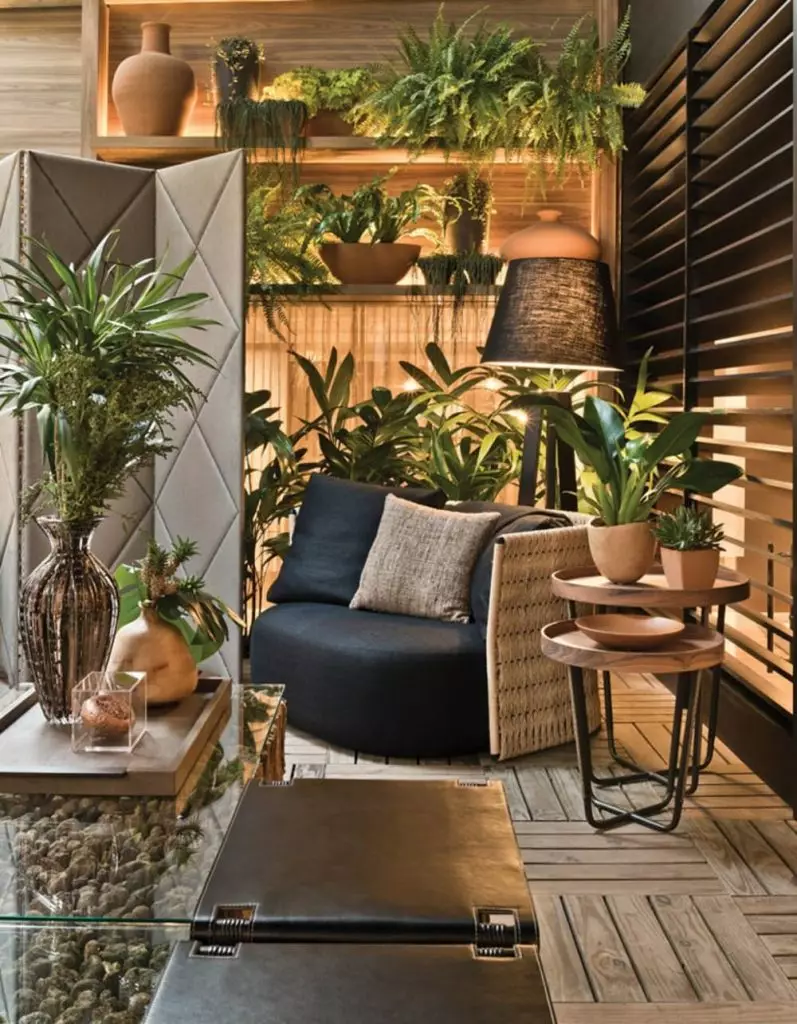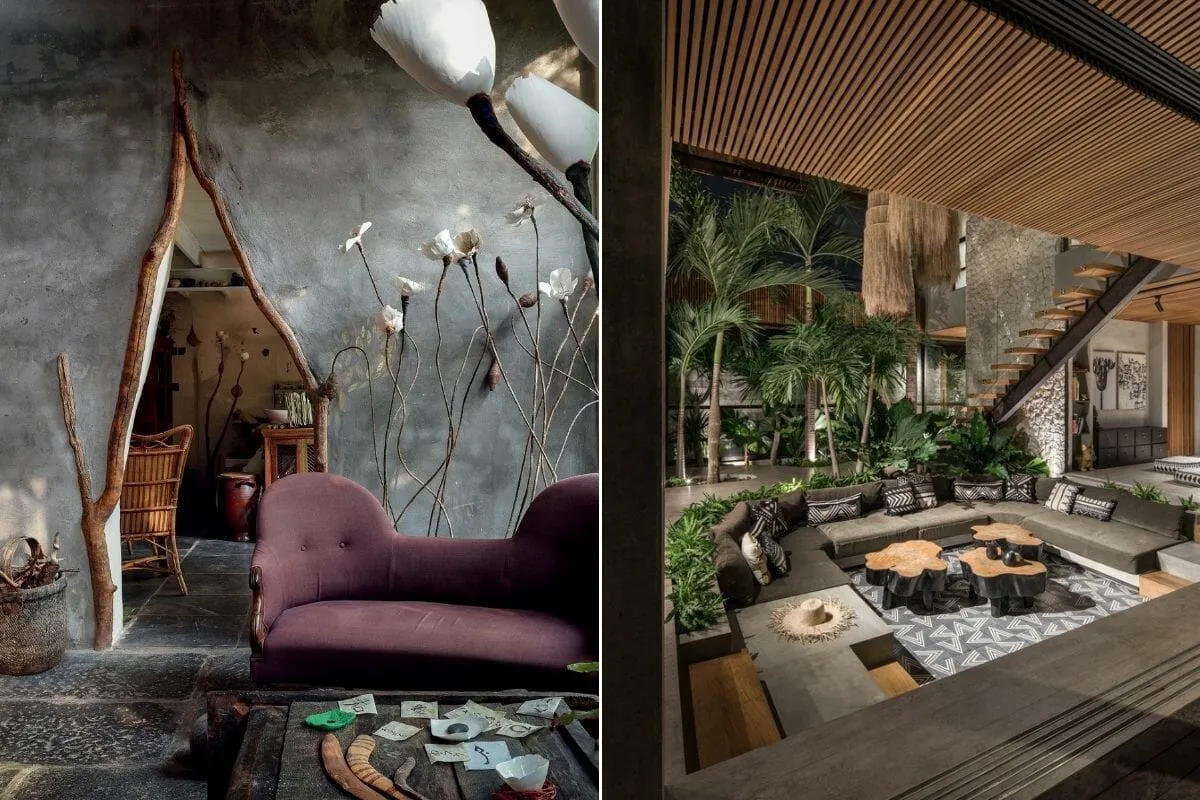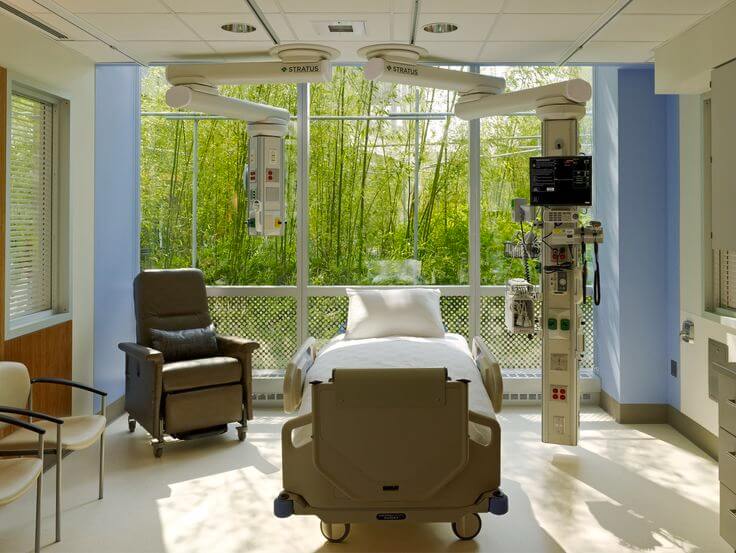Crafting Your Biophilic Interior Design Home [2024]
PartyLite.com Have you ever walked into a space that instantly made you feel calm and at ease, yet couldn't pinpoint why? It could be the magic of the biophilic interior design...
PartyLite.com Have you ever walked into a space that instantly made you feel calm and at ease, yet couldn't pinpoint why? It could be the magic of the biophilic interior design...

Have you ever walked into a space that instantly made you feel calm and at ease, yet couldn't pinpoint why? It could be the magic of the biophilic interior design home.
This transformative approach weaves elements from nature - light, color, texture - into our everyday spaces. A glimpse outside your window may reveal towering trees or gentle waves; imagine bringing that tranquility indoors.
We're not just talking potted plants here. We mean truly integrating nature's essence with modern living for better health and happiness.
The connection is deeper than aesthetics; it's about human-nature relationship. That's what the biophilic interior design home is all about.
In this exploration, expect to dive deep under the canopy of biophilic principles, learn how natural light can uplift moods or how art strengthens our bond with Mother Nature herself.

You may have heard the term 'biophilic interior design' and wondered what it means. Well, this intriguing design philosophy revolves around integrating natural elements into built environments to boost human health and well-being. Think of lush green plants in a living room or wooden furniture echoing the serenity of nature.
To incorporate biophilic interior design principles involves creating an intimate visual connection between humans and nature. A study has shown that when we surround ourselves with nature-like design elements at home, our cognitive function improves dramatically.
The pioneers behind these innovative concepts are none other than Edward Wilson and Stephen Kellert. Wilson brought forth the idea of 'biophilia,' suggesting an inherent bond between humans and other living systems, while Kellert developed practical guidelines for applying these ideas in architecture.
Embracing biophilic interior design means inviting nature into your home, boosting health and well-being. This is more than a style trend; it's backed by science. By adding plants or allowing more sunlight in, you enhance air quality and regulate body rhythms. Plus, natural materials like wood and stone add a unique charm to your space.
Imagine stepping into a room bathed in soft, natural light. The gentle hues of the dawn or dusk sun play off the vibrant colors inspired by nature that adorn your space. A feeling of tranquility washes over you right away. That's a big priority for biophilic interior designers. They focus on creating spaces that maximize our connection to nature.

The importance of natural light in biophilic design cannot be overstated. It has profound effects on our well-being and productivity levels. Studies have shown that natural light and plants boost motivation and productivity.
Natural sunlight supports vitamin D production in our bodies, crucial for bone health among other benefits like boosting mood and energy levels.
To get this valuable resource inside your home or office isn’t as difficult as it might seem – it’s simply a matter of designing spaces to maximize natural light wherever possible.
This could mean larger windows, skylights, glass doors; basically anything that lets daylight pour into your indoor environment freely.

Beyond just lighting up rooms with sunshine though, color plays an equally important role when seeking harmony with Mother Earth in your biophilic interior design home.
Choosing natural color schemes inspired by nature is another key strategy here - think leafy greens, sky blues or earth tones which subtly mirror the great outdoors.
Not only do these palettes soothe eyes tired from looking at screens all day long but they also add visual interest without overwhelming senses.
This balance helps foster peaceful environments conducive to relaxation after hectic days full throttle.
In conclusion: embracing both sunlight & naturally inspired colors are essential components of biophilic design, bringing not just beauty but health benefits too into our everyday spaces.
For more insight on how you can adopt these principles at home or work, check out this guide on the Pros of Biophilic Designs.
Imagine walking into a room, filled with the soft glow of natural light and colors borrowed from nature. That's biophilic interior design for you - it's all about creating calmness.
Remember, sunlight doesn't just brighten your space; it lifts your mood, energizes you and helps produce vitamin D too.
Picture your living space filled with the rich, earthy textures of wood and stone. Now imagine how much more inviting it would feel if you add some lush greenery to this setting. This is the essence of using natural materials in interior design.
The versatility of wood, stone, and other natural materials makes them ideal for creating biophilic interiors that connect us with nature on a profound level. But there's more to these elements than just aesthetics.
A well-placed wooden table or a stone accent wall can significantly enhance air quality within your home by naturally purifying the air we breathe. They also foster a multi-sensory experience that engages our senses – sight, touch, even smell - contributing positively to our mood and emotional regulation.

©The Dalmar / Bob Gundu / Jay Scotts
Natural elements bring warmth into an otherwise sterile environment making it welcoming and calming. They are not only pleasing visually but can have therapeutic effects too. Studies show that interiors incorporating biophilic principles like these can improve overall well-being while reducing indoor pollutants by as much as 20%.

We often associate "natural" with wood or stone because they're commonly used building materials but let's expand our thinking here. What about clay? Clay plasters give walls texture while regulating humidity levels indoors; perfect for people suffering from allergies or respiratory problems.
Cork floors offer comfort underfoot due to their softness which reduces noise pollution too – something apartment dwellers will appreciate.
You've got your beautiful furniture made from reclaimed oak paired perfectly with travertine tiles now what? Add some greenery of course. Incorporating plants and greenery into your space not only increases its aesthetic appeal but also improves air quality, making the environment healthier.
Tall leafy ferns in the corners or a tabletop succulent garden can instantly breathe life into any room. If you're worried about maintenance, there are many indoor plant varieties that require minimal care.

Did you say moss walls? Yes, that's right.
Picture your home filled with the rich textures of wood, stone, and vibrant greenery. Incorporating natural materials into your decor doesn't just create a cozy, welcoming environment—it also cleanses the air and boosts well-being.
But don't stop at common choices like wood or stone—think about unique options such as clay plasters or cork floors for their distinct advantages. And remember to weave plants into your interior design.
We've all heard the phrase, "Bring the outdoors in." But what does it really mean? Well, at Woodland Pulse, we like to think of it as a way to create an indoor sanctuary that not only looks good but feels great too. Let's dive into some creative ways you can incorporate this trend.

© Piranka / Getty
Incorporating art and photography is one way to strengthen your connection with nature indoors. These visuals often serve as reminders of our favorite outdoor moments or places. It could be a picture from your last beach vacation or an artwork showcasing the beautiful woods you love hiking through.
The trick here is picking pieces that resonate with you personally because they give off positive vibes every time you look at them. And hey, why stop there? You could even go for indoor landscaping, creating miniature gardens within your living space.
This takes us to another fascinating concept - indoor gardens and living walls. These installations bring literal life into your spaces while improving air quality significantly (remember key stat 5?). Plus, let's face it; nothing beats having fresh greenery around.
A corner filled with potted plants might seem old school but believe me when I say – it never goes out of style. They add character while acting as natural humidifiers and air purifiers — talk about beauty meets functionality. Vertical gardening also helps if floor space is scarce—going up isn't just for city buildings anymore.
Hanging plants are another popular option these days—they literally hang around adding freshness everywhere they sway. With their ability to thrive in various light conditions coupled with low maintenance requirements—they're indeed hard workers on the quiet.
Technology too has a significant role in simulating natural environments indoors. Innovations like LED grow lights and automated watering systems make it easier than ever to keep your indoor greenery thriving.
In essence, the idea is not just about bringing plants inside but creating an environment where they can thrive—giving you all their benefits while adding aesthetic value to your space.
Making a biophilic interior design home involves creating a calming haven by embracing nature. Add personal touches like art or photos of outdoor scenes you adore, or experiment with indoor landscaping using tiny gardens for an extra breath of freshness.
If space is tight, consider trendy solutions like vertical gardening and hanging plants - they're not just stylish but also help clean the air. Don't forget to use tech tools such as LED grow lights and automated systems.
The principles of biophilic design aren't confined to just residential spaces or office settings. The magic happens when we realize that these concepts can be woven into a variety of different environments.

Let's take healthcare facilities as an example. These places, often filled with stress and anxiety, could use some love from Mother Nature. And guess what? Biophilic design has got it covered.
Hospitals and clinics are starting to recognize the healing power of nature-inspired interiors. When patients see greenery around them, they feel more relaxed and positive about their recovery journey.
In fact, research shows us that individuals recover faster when exposed to natural light and plants - all key elements of biophilic design.
Moving onto our homes – our sanctuaries after a long day at work. Don’t you think they deserve the best?
Absolutely. So let’s start incorporating those soothing earthy tones, indoor plants for cleaner air quality, open windows for sunlight penetration – making sure every nook echoes 'biophilia' loud and clear.
Moving on to office settings. Just imagine walking into an office with lush green plants, sunshine pouring in through large windows and the texture of natural materials under your fingertips.
A place where stress levels dip, creativity blossoms and productivity soars – a perfect example of how incorporating biophilic elements in office settings can transform workspaces into well-being spaces.
Curious about who's behind all this? Let's dive deeper.
Biophilic design's magic lies in its versatility. From reducing stress in healthcare facilities to enhancing focus and productivity in offices, it introduces nature's healing power into various settings.
In a biophilic interior design home, embracing earthy tones, sunlight penetration, and indoor plants can create an environment that echoes 'biophilia', reminding us of the great outdoors where humans first evolved.
As we move forward, the growing popularity of having a biophilic interior design home isn't slowing down. Quite the opposite. It's making a wave in modern interior architecture and becoming an important part of sustainable living. More and more people are looking to create a biophilic interior design home.
The wonders don't stop at potted plants or green walls. Thanks to technological advancements, we're pushing boundaries on how nature can be incorporated into our homes and offices. Now imagine walking indoors but still feeling like you're outside? That's what these innovations are bringing about.
Research shows that even seeing shades of green can lower your heart rate.
We've seen changes where home designers use virtual reality to create a natural environment inside four walls - sounds interesting right? But why is all this fuss about integrating nature with design?
This growing trend has many people redesigning their spaces using natural materials, textures, patterns – basically anything that mimics outdoor elements.And here’s an exciting bit: creating a biophilic interior design home doesn’t have to break your bank.
"Wait…what?"
You heard me right. I’m talking affordable yet stylish options. Ever thought cork could look so chic as wall panels or floor tiles? Well...surprise.
So if you're looking to add a fresh spin to your space, biophilic design is the way forward. And with its proven impact on sustainability, it's not just about aesthetic appeal anymore.
Think of it like this - you're not just inviting nature into your home, but also doing a solid for Mother Earth. It's a win-win situation... and no birds get hurt.
Embrace the future of interior design with biophilic concepts. They're more than just trendy; they're sustainable and good for your well-being too.
From tech innovations to using natural materials, there are many ways to bring nature indoors without breaking the bank. Plus, it's a stylish way to show some love for Mother Earth.
FAQs in Relation to Biophilic Interior Design HomeWhat is biophilic design in interior design?Biophilic design connects us with nature. It uses natural light, plants, and materials like wood or stone to make our indoor spaces healthier and more uplifting. How can I make my home biophilic?To create a biophilic interior design home, let natural light flood in. Use greenery liberally, opt for earthy colors and incorporate natural elements like wood or stone into your decor. What is a biophilic house?A biophilic house creates an intimate connection between its occupants and the outdoors. Natural light dominates these spaces filled with plant life, eco-friendly materials and designs inspired by nature's patterns. What are the disadvantages of biophilic design?The main drawbacks of biophilic design could be higher costs due to using premium organic materials or maintaining live plants; however, many argue that benefits outweigh these initial expenses over time. |
Designing a biophilic interior design home is not just about aesthetics. It's building an intimate connection with nature, right within your four walls.
Natural light and color play vital roles in uplifting moods, boosting productivity. Remember that every ray of sunlight counts!
From wood to stone, using natural materials enhances air quality while adding a touch of authenticity to your spaces. Be bold; explore the versatile world of natural elements.
The idea is simple: bring more green indoors! Whether it's through indoor gardens or art pieces that evoke the outdoors, let nature be part of your daily life.
Beyond homes and offices, even healthcare facilities can harness these principles for healing environments. That's biophilic design spreading its roots across diverse settings!
A future where our interiors foster well-being isn't far off anymore - it’s here now! So embrace this growing trend and style your biophilic interior design home.
Looking to add biophilically designed modern plant pots to your space? Browse the most unique collection of passive diffuser biophilic plant pots, here!
Your Essential Resource for Indoor Houseplant Lovers and Home Decor Enthusiasts

Explore the range of unique vases at Woodland Pulse. Discover modern organic decor for your home. Shop now!

Explore the world of garden clips with Woodland Pulse's expert guide. Learn how Thriving Design's innovative clips can transform your gardening experience, blending functionality with style.

Transform your indoor space into a green sanctuary with our selection of the 20 best tall indoor plants. These towering beauties do more than just enhance the aesthetics of a room; they...
Your cart is currently empty.
Start Shopping